Presidents: James Madison
Birthplace: Port Conway, Virginia
Visited in 2008.
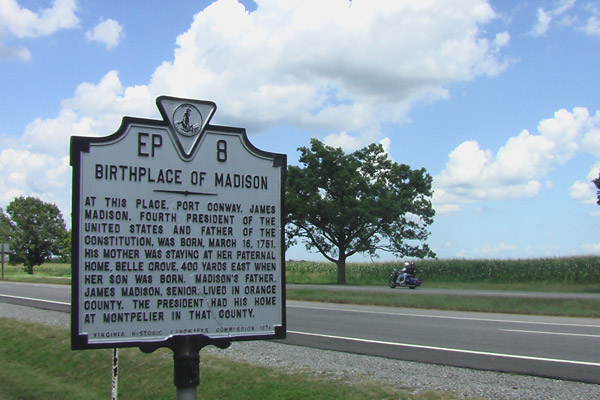
Outside of a flat tire, the best reason to pull over on US-301.
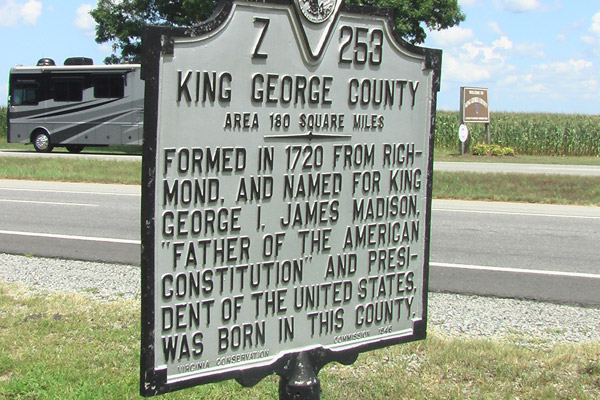
Yes, the sign has two sides. That's the kind of opulence we expect from Virginia.
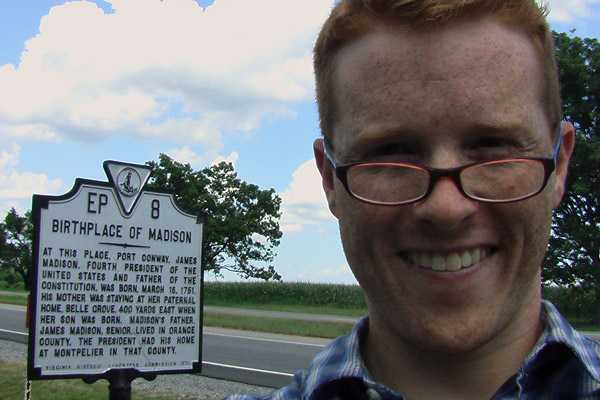
This settles the horrid rumors that I never actually went.
James Madison, father of the Constitution and our fourth president, was born in a drainage ditch on the the side of US-301. Hey, I was just as shocked as you probably are.
The actual story: The Belle Grove plantation was the childhood home of Madison's mother, Eleanor Rose Conway. She was living there when she met James Madison Sr., a well-to-do farmer who was in the area trying to offload his tobacco crop. Belle Grove was right by the banks of the Rappahannock River, which flows right into the Chesapeake Bay. If you were a wealthy plantation owner who had to offload his daughters on Virginia society, the plantation was a strategically located man trap. They had to come to you.
Flash forward a few years, and "Nelly" and James were expecting their first child in the winter of 1750. Nelly opted to visit her parents -- or James opted to send her to her parents -- in December 1750. She hung out there for a few months, and in March nature took its course.
There's nothing to see, as the original plantation house burned to the ground at some point in the 1700s, and no magic oak tree sprang from the soil on the spot where James Madison Jr.'s placenta fell. Someone bulit a replacement plantaion house, and as of 2019 it's being operated as a bed and breakfast. If you're in to that sort of thing, you and your significant other can stay in a house relatively close to where James Madison was born, and have that special awkward bed-and-breakfast sex, where you probably meet face-to-face with the people who will have to clean your room.
You probably won't produce another James Madison, but if you do, WHOOOO will that be a good story.
Montpelier, Orange County, Virginia
Visited in 2008, 2015 and 2017.
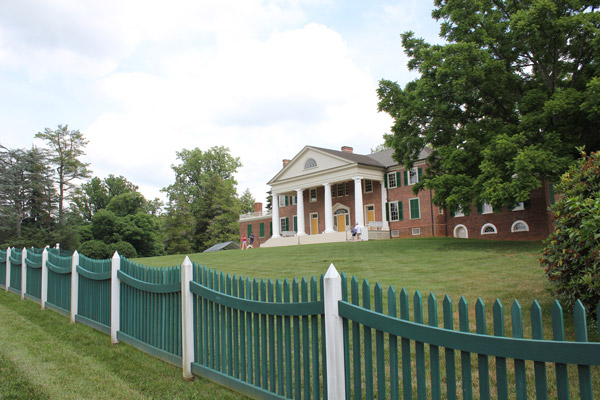
The beautifully restored home of James Madison.
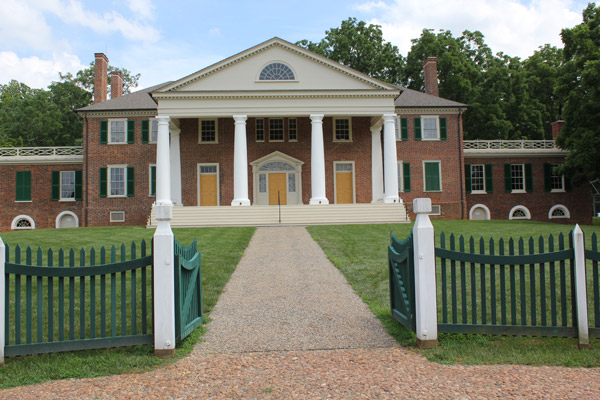
Portico by Jefferson. Construction by ... uh, slave labor, probably.
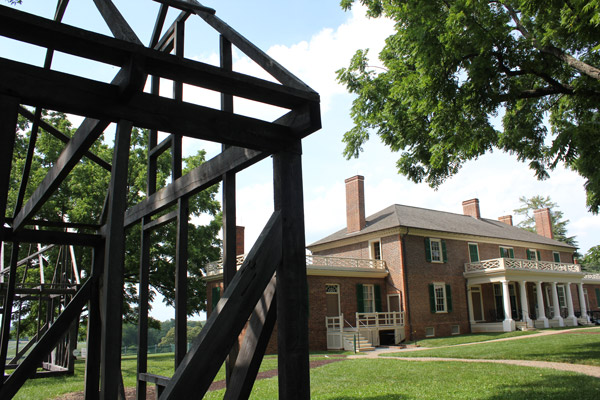
The frame of a replica "outbuilding" in 2015.
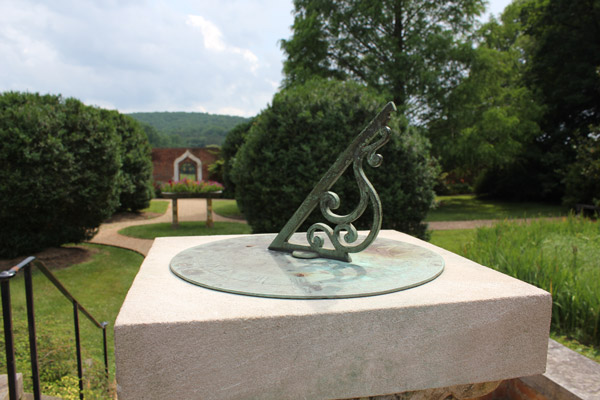
The duPonts' walled garden isn't Madisonian, but it's really nice.
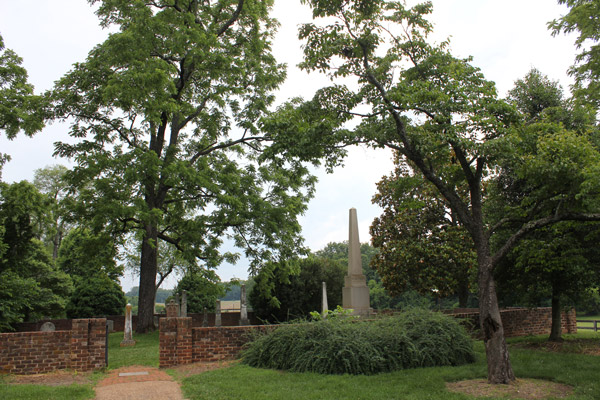
James Madison was involved in more plots than just the Revolution.
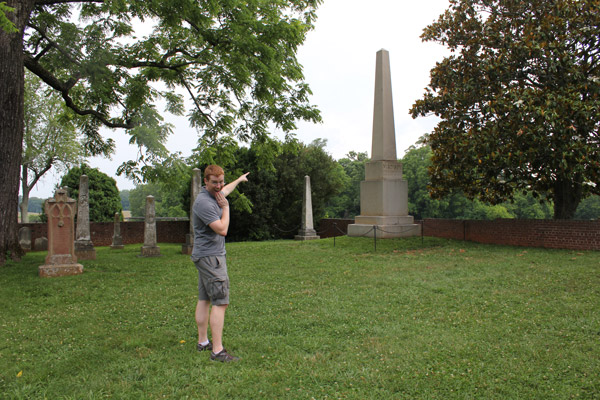
Nobody puts Dolley in a corner! Except for the guy who buried her.
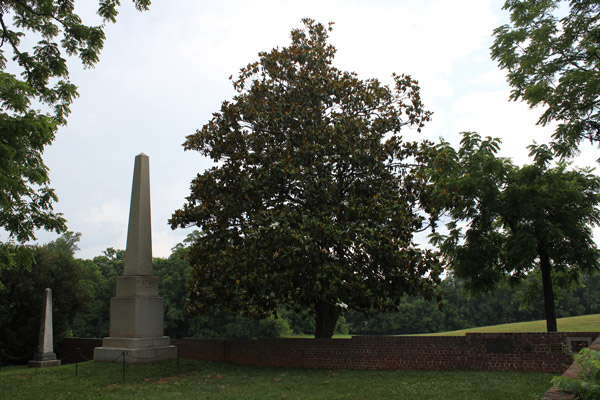
Another view of the Madisons' final resting place.
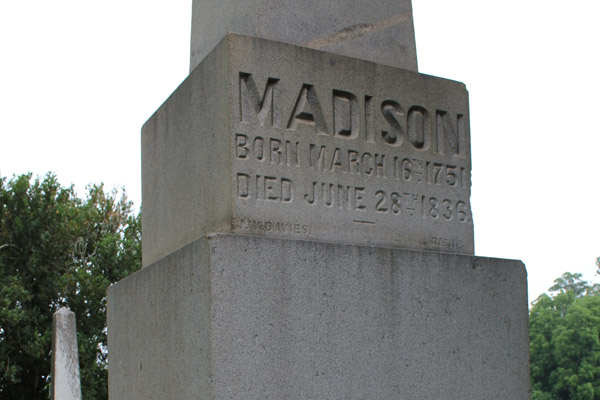
A pretty short inscription for a pretty short man.
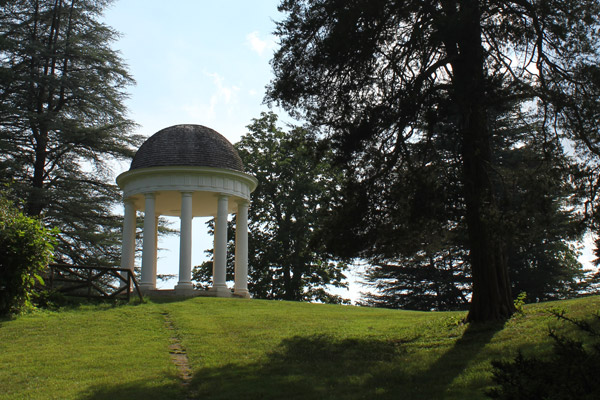
The "temple," which is also the entrance to the ice house.
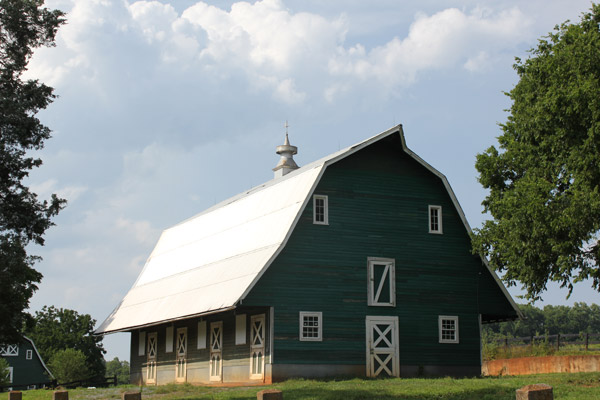
One of the barns from the duPont's equine operations.
As you get older, life is less about figuring out who you want to be and more about finding the people who will tolerate the wackadoo you've become. On my 32nd birthday, there were several people willing to take me to James Madison's house. I'm a lucky guy! And as you get older still, you come to realize that such friends are hard to come by, and you don't want to scare them off with your weird hobbies if at all possible. So in the summer of my 38th year, I went to James Madison's house by myself.
The point is, I've been to Montpelier twice. In 2008, the home had just been opened to the public after a years-long renovation and preservation program. It had ballooned to 55 rooms under the care of the duPonts, the great American family which understands that money is pointless unless you spend it. Some duPonts spend it on murdering Olympic wrestlers, but Marion duPont Scott decided to be a little more constructive with her chunk of the family fortune. She bought a president's house, then used the grounds to raise champion racehorses. There are still race tracks and barns left over from that operation, and there's also a really nice display in the Montpelier visitors center dedicated to Marion's legacy. (Fun note: the Scott in Marion duPont Scott comes from Randolph Scott, whom you probably haven't heard of if you're under the age of 50, unless you've seen "Blazing Saddles," in which case you may remember when Bart gets the townspeople to listen to his plan to build the fake Rock Ridge by saying, "You'd do it for Randolph Scott," and then a choir sings "RAN-DOLPH SCOTT," as all the people cover their hearts. He was a huge Western star, and he eventually divorced Marion, since for the most part he lived in Hollywood. I love history.)
The renovation involved removing 33 of the rooms and restoring the interior to its early 19th-century glory. In 2008, the exterior looked amazing, but the interior was almost entirely undecorated; curators were in the process of researching the interior decor and hunting down any surviving Madison-era furniture that had slipped onto the presidential furniture black market. The tour guides did their best, trying to explain all the important paperwork that James Madison filed to officially organize the LLC we now call America. But it was still a little underwhelming to hear that story in a bunch of empty rooms.
By 2015 the difference was palpable. PALPABLE, I SAY! Apparently the teams of whip-toting archaeologists were getting the job done. The interior included several furnished rooms that are a close approximation of what the Madisons would have enjoyed. The exterior has also also seen some changes. Thanks to generous donations from history-loving maniacs like you, they have continued archaeological digs to find "out buildings" (slave quarters, etc.) and even started to put up some replica structures. Plus, the guides will still give you the James Madison saga.
Madison's grandpa bought the spread that is now Montpelier. It was your standard slave-operated tobacco plantation. James Madison was the oldest of about 53 children. He was sickly, so his father shipped him off to enjoy the healing waters of New Jersey for schooling. He finished the 4-year program of the College of New Jersey (now known as Princeton) in two years. He then became the "first graduate student" in the the history of Princeton by studying with John Witherspoon, the university president and star of the "Friday" movies.
Manly physical pursuits weren't an option for Madison, who continued to be sickly throughout his life and topped out at 5'4". He started dabbling in state politics and soon befriended Thomas Jefferson, who became his lifelong sugardaddy. Madison did a veritable crapload of reading on philosophy and civics and that sort of thing, so he was a natural choice for the Continental Congress. And when the government of young America was struggling, he was a natural choice to reorganize it. After initiating the process that led to the Constitutional Convention, Madison became the point man for the creation of that document. His development of and advocacy for the "Virginia plan" (a bicameral legislature) had a huge impact on the formation of the legislative branch.
After that he served in the House that he helped invent, became Jefferson's Secretary of State and then the fourth president of these United States. After presiding over the burning-down of the White House in 1814, he retired to Montpelier and died there in 1836. He was the last of the Founding Fathers to kick the bucket.
If all that sounds boring to you, it's because it KIND OF IS! Madison doesn't have the panache of the other bigwigs from his era. He didn't fight in the Revolution, he wasn't too big of a personality, he didn't invent things, and he didn't have syphilis. All his big accomplishments, aside from marrying a lady with a great rack, are on paper. That's probably why they call him the forgotten Founding Father: because Americans hate nerds.
Which isn't to say that Montpelier isn't cool. There's the study where he formulated his plans for the Constitution, the room where he died, the dining room where he and Dolley entertained thousands of guests, the guest bedroom where Jefferson crashed when headed to or from Monticello. (Also, it's fun to know that Jefferson designed the home's portico.) The house tells you something about family priorities -- it's a duplex, since Madison's mom had her own wing to live in after her husband's death. The grounds are very nice to stroll around. There's a quaint little temple over top of Madison's ice house and a nice walled garden left over from the duPonts.
Plus there's a graveyard! Madison died at Montpelier, and his family cemetery is just a stone's throw away from the mansion. So you can enjoy the very plain obelisk{/modal} sitting on top of James Madison, and the very small plain obelisk on top of Dolley. They're surprisingly simple, and very beaten down by time. Dolley's marker looks like it's been split in twain and then glued back together. More people need to insist on being buried in their yard. It would make for a far more interesting real estate market.
The Octagon, Washington, D.C.
Visited in 2015 and several other times.
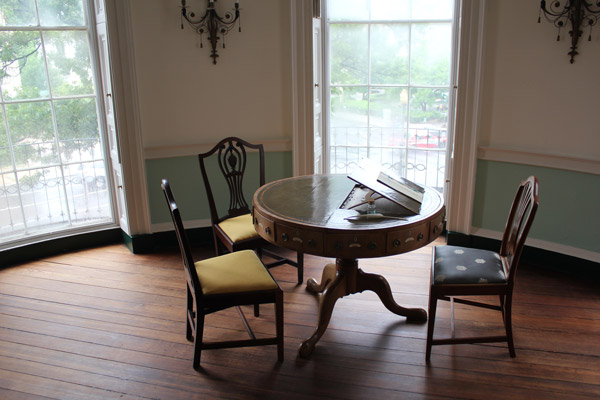
The desk where the war of 1812 ended, sort of.
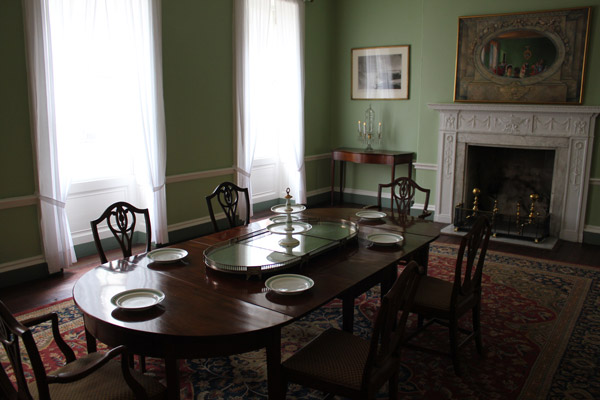
Just because your first mansion burned down doesn't mean you can't enjoy fine dining.
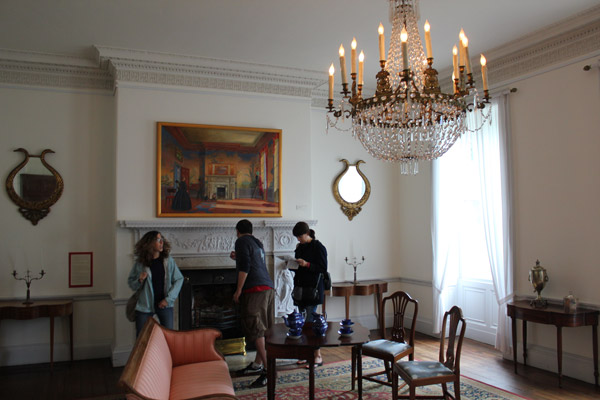
One of the parlors in the very elegant temporary White House.
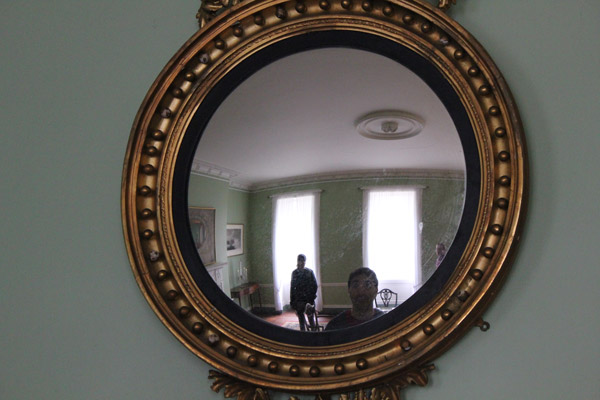
Madison's magic mirror, used to spy on Henry Clay.
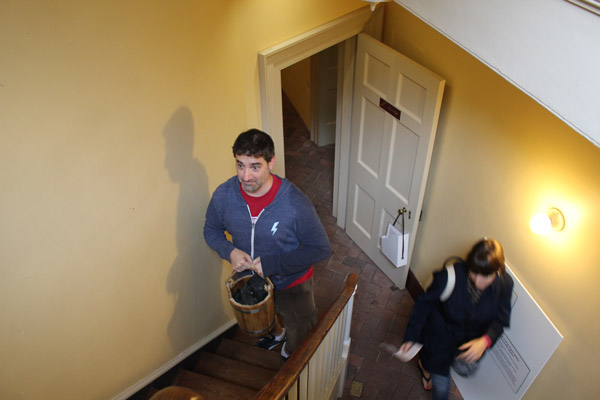
Carrying a coal bucket up the back stairs -- i.e. the stairs the slaves and servants used.
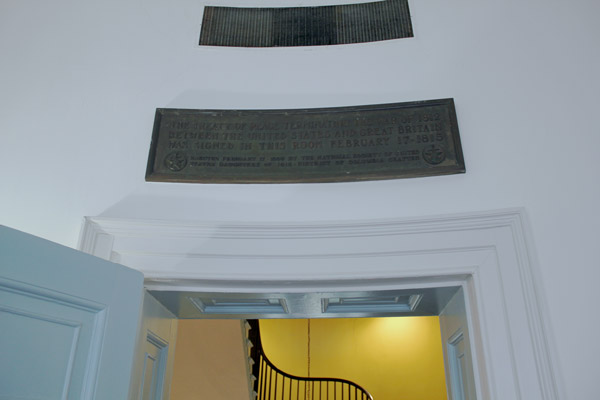
Plaque buildup at the Octagon.
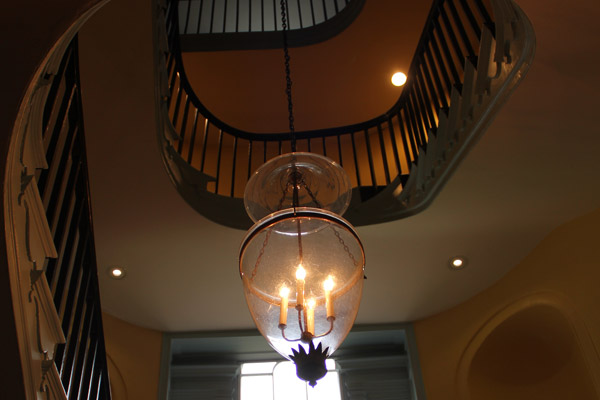
The main stairs. The surefire way to impress guests in the 1810s was nice stairs.
Having a house is great, but there's always something to worry about. Maybe you need a new roof. Maybe your water heater is about to go. Or maybe British soldiers want to set fire to your home as a giant F-U to the nation that you're leading.
James Madison encountered the third of these problems in August 1814. The United States and Great Britain were in the middle of a very silly conflict, and the United States was half-assing its war effort. The military was disorganized, defenses were anemic and half the Congress didn't even want to fund the war. The British, who were probably still a little embarrassed about the Revolution, decided to have some fun with it. A bunch of British troops sailed up the Chesapeake Bay, landed in Maryland and made their way to DC after crushing a pathetic resistance. The delightfully named Admiral Cockburn had his underlings burn most of Washington, including the White House. Madison and his wife had to get the hell out of dodge. (Cockburn later appeared in one of the most bad-ass portraits of all time, with a burning Washington in the background.)
Madison had to be in a bad place, since his landlord was the entire American populace. He probably lost some of his favorite shirts and inspirational cat posters in the fire. He was homeless (except for his very large home in Orange County, Virginia, but let's forget about that for now). Fortunately, life's never THAT bad when you have rich friends. James Tayloe was one of the wealthiest planters in Virginia. He built one of the first private residences in the District of Columbia, designed by William Thornton (who also designed the U.S. Capitol). To accommodate an unusually shaped lot, the home was a bit unconventional in shape. It had six sides, and so it became known as ... the Octagon.
There are several possible explanations for this discrepancy, but let's just say that people did a lot of day-drinking back then.
Among its many virtues, the Octagon was about a third of a mile from the White House. Tayloe opened his home to the Madisons -- what the heck, he had plenty of other mansions to spare -- and the Octagon became the executive residence for about six months. Madison eventually wrapped up the war while living there; the desk he used to sign the Treaty of Ghent is on display in the upstairs room where Madison actually did the signing.
Beyond that, the Octagon is just a neat place. The building went through a few phases after the Tayloes gave up possession in the 1850s, even becoming a tenement at one point. Through it all, it remained a nice example of Federalist architecture, and the American Institute of Architects acquired the building early in the 20th century. It was their DC headquarters for a long time, and after they moved into an adjacent office building, they started restoring it to its original appearance. Now it's operated as a historical site, with some rotating exhibits on architecture thrown in for good measure.
You can tour the whole thing in about 30 minutes. Even if you're not an architecture dork, you can enjoy the elegant recreations of the dining room and the parlor, plus the distinctive features and angles that you get from having a hexagonal house. I can't tell you WHY the staircases look cool, but they look cool. Madison didn't leave much of a mark on the building, but that's not such a bad thing. All the marks he left on the White House, after all, were soot stains.
